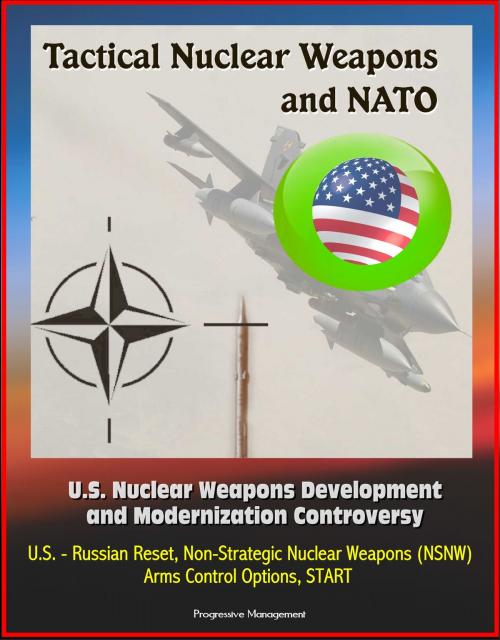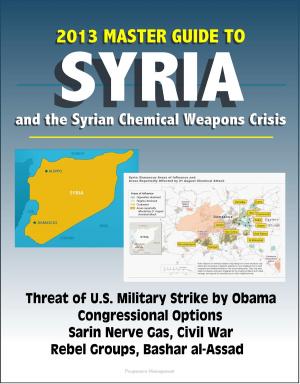Tactical Nuclear Weapons and NATO - U.S. Nuclear Weapons Development and Modernization Controversy, U.S. - Russian Reset, Non-Strategic Nuclear Weapons (NSNW), Arms Control Options, START
Nonfiction, History, Military, Nuclear Warfare, Asian, Russia| Author: | Progressive Management | ISBN: | 9781310872457 |
| Publisher: | Progressive Management | Publication: | March 11, 2014 |
| Imprint: | Smashwords Edition | Language: | English |
| Author: | Progressive Management |
| ISBN: | 9781310872457 |
| Publisher: | Progressive Management |
| Publication: | March 11, 2014 |
| Imprint: | Smashwords Edition |
| Language: | English |
This important report from the U.S. Army's Strategic Studies Institute provides the complete history of tactical nuclear weapons starting with the early days of the Cold War, along with unique up-to-date insights into the future of tactical nukes in Europe and Asia.
The role and future of tactical nuclear weapons in Europe are subjects that sometimes surprise even experts in international security, primarily because it is so often disconcerting to remember that these weapons still exist. Many years ago, an American journalist wryly noted that the future of the North Atlantic Treaty Organization (NATO) was "a subject that drives the dagger of boredom deep, deep into the heart" — a dismissive quip which would have remained true right up until the moment World War III broke out. The same goes for tactical nuclear weapons: compared to the momentous issues that the East and West have tackled since the end of the Cold War, the scattering of hundreds (or in the Russian case, thousands) of battlefield weapons throughout Europe seems to be almost an afterthought, a detail left behind that should be easy to tidy up.
Such complacency is unwise. Tactical nuclear weapons (or NSNWs, "non-strategic nuclear weapons") still exist because NATO and Russia have not fully resolved their fears about how a nuclear war might arise, or how it might be fought. They represent, as Russian analyst Nikolai Sokov once wrote, "the longest deadlock" in the history of arms control. Washington and Moscow, despite the challenges to the "reset" of their relations, point to reductions in strategic arms as a great achievement, but strategic agreements also reveal the deep ambiguity toward nuclear weapons as felt by the former superpower rivals. The numbers in the 2010 New Strategic Arms Reduction Treaty (New START) are lower than at any point in history, but they are based on leaving each side a reliable ability to destroy up to 300 urban targets each. Inflicting this incredible amount of destruction is, on its face, a step no sane national leader would take.
Preface * Tactical Nuclear Weapons and NATO: An Introductory Reminiscence * PART I. THE HISTORICAL CONTEXT OF TACTICAL NUCLEAR WEAPONS * 1. The Historical Context * 2. Tactical Nuclear Weapons in NATO and Beyond: A Historical and Thematic Examination * 3. U.S. Nuclear Weapons Policy and Policymaking: The Asian Experience * PART II. RUSSIAN PERSPECTIVES ON TACTICAL NUCLEAR WEAPONS * 4. Russian Perspectives on Tactical Nuclear Weapons * 5. Russian Doctrine on Tactical Nuclear Weapons: Contexts, Prisms, and Connections * 6. Aspects of the Current Russian Perspective on Tactical Nuclear Weapons * 7. Influences on Russian Policy and Possibilities for Reduction in Non-Strategic Nuclear Weapons * 8. Russian Perspectives on Non-Strategic Nuclear Weapons * PART III. EUROPEAN PERSPECTIVES * 9. Introduction of European Policies and Opinions Relating to Tactical Nuclear Weapons * 10. The Role and Place of Tactical Nuclear Weapons — A NATO Perspective * 11. European and German Perspectives * 12. European Perspectives * 13. Europe, NATO's Tactical Nuclear Conundrum, and Public Debate: Be Careful What You Wish For * PART IV. AMERICAN PERSPECTIVES * 14. American Perspectives on Tactical Nuclear Weapons * 15. The Role of Non-Strategic Nuclear Weapons: An American Perspective * 16. NATO's Nuclear Debate: The Broader Strategic Context * 17. Role of Nuclear Weapons in NATO's Deterrence and Defense Posture Review: Prospects for Change * PART V. ARMS CONTROL AS AN OPTION * 18. Tactical Nuclear Weapons and NATO: Arms Control as an Option * 19. Arms Control Options for Non-Strategic Nuclear Weapons * 20. Tactical Nuclear Weapons and NATO: A Conventional Arms Control Perspective * 21. Arms Control after START * 22. The Conventional and Nuclear Nexus in Europe * PART VI. CONCLUSION * 23. Summing Up and Issues for the Future
This important report from the U.S. Army's Strategic Studies Institute provides the complete history of tactical nuclear weapons starting with the early days of the Cold War, along with unique up-to-date insights into the future of tactical nukes in Europe and Asia.
The role and future of tactical nuclear weapons in Europe are subjects that sometimes surprise even experts in international security, primarily because it is so often disconcerting to remember that these weapons still exist. Many years ago, an American journalist wryly noted that the future of the North Atlantic Treaty Organization (NATO) was "a subject that drives the dagger of boredom deep, deep into the heart" — a dismissive quip which would have remained true right up until the moment World War III broke out. The same goes for tactical nuclear weapons: compared to the momentous issues that the East and West have tackled since the end of the Cold War, the scattering of hundreds (or in the Russian case, thousands) of battlefield weapons throughout Europe seems to be almost an afterthought, a detail left behind that should be easy to tidy up.
Such complacency is unwise. Tactical nuclear weapons (or NSNWs, "non-strategic nuclear weapons") still exist because NATO and Russia have not fully resolved their fears about how a nuclear war might arise, or how it might be fought. They represent, as Russian analyst Nikolai Sokov once wrote, "the longest deadlock" in the history of arms control. Washington and Moscow, despite the challenges to the "reset" of their relations, point to reductions in strategic arms as a great achievement, but strategic agreements also reveal the deep ambiguity toward nuclear weapons as felt by the former superpower rivals. The numbers in the 2010 New Strategic Arms Reduction Treaty (New START) are lower than at any point in history, but they are based on leaving each side a reliable ability to destroy up to 300 urban targets each. Inflicting this incredible amount of destruction is, on its face, a step no sane national leader would take.
Preface * Tactical Nuclear Weapons and NATO: An Introductory Reminiscence * PART I. THE HISTORICAL CONTEXT OF TACTICAL NUCLEAR WEAPONS * 1. The Historical Context * 2. Tactical Nuclear Weapons in NATO and Beyond: A Historical and Thematic Examination * 3. U.S. Nuclear Weapons Policy and Policymaking: The Asian Experience * PART II. RUSSIAN PERSPECTIVES ON TACTICAL NUCLEAR WEAPONS * 4. Russian Perspectives on Tactical Nuclear Weapons * 5. Russian Doctrine on Tactical Nuclear Weapons: Contexts, Prisms, and Connections * 6. Aspects of the Current Russian Perspective on Tactical Nuclear Weapons * 7. Influences on Russian Policy and Possibilities for Reduction in Non-Strategic Nuclear Weapons * 8. Russian Perspectives on Non-Strategic Nuclear Weapons * PART III. EUROPEAN PERSPECTIVES * 9. Introduction of European Policies and Opinions Relating to Tactical Nuclear Weapons * 10. The Role and Place of Tactical Nuclear Weapons — A NATO Perspective * 11. European and German Perspectives * 12. European Perspectives * 13. Europe, NATO's Tactical Nuclear Conundrum, and Public Debate: Be Careful What You Wish For * PART IV. AMERICAN PERSPECTIVES * 14. American Perspectives on Tactical Nuclear Weapons * 15. The Role of Non-Strategic Nuclear Weapons: An American Perspective * 16. NATO's Nuclear Debate: The Broader Strategic Context * 17. Role of Nuclear Weapons in NATO's Deterrence and Defense Posture Review: Prospects for Change * PART V. ARMS CONTROL AS AN OPTION * 18. Tactical Nuclear Weapons and NATO: Arms Control as an Option * 19. Arms Control Options for Non-Strategic Nuclear Weapons * 20. Tactical Nuclear Weapons and NATO: A Conventional Arms Control Perspective * 21. Arms Control after START * 22. The Conventional and Nuclear Nexus in Europe * PART VI. CONCLUSION * 23. Summing Up and Issues for the Future















